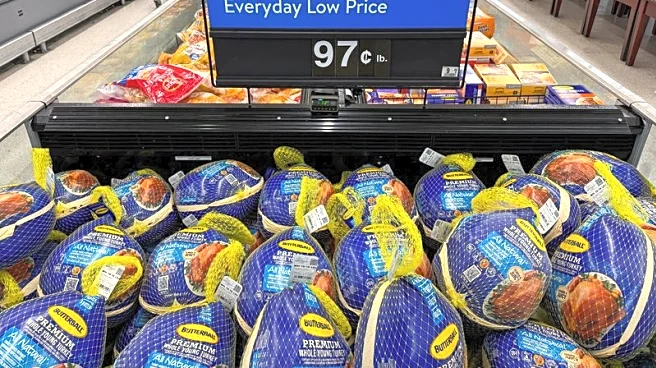What's Happening?
The American Farm Bureau Federation has released its 40th annual Thanksgiving dinner survey, revealing a decrease in the cost of a traditional Thanksgiving meal for the third consecutive year. The average
cost for a dinner serving ten people is now $55.18, a 5% reduction from the previous year. This decline follows a record-high cost of $64.05 in 2022. The price drop is largely attributed to a significant decrease in turkey prices, with a 16-pound frozen turkey now costing $21.50, down more than 16% from last year. Despite the wholesale price for fresh turkey being up, retail prices have fallen due to grocery store promotions aimed at boosting consumer demand. Other items such as dinner rolls and stuffing have also seen price reductions, while fresh vegetables and sweet potatoes have increased due to factors like natural disasters and supply chain disruptions.
Why It's Important?
The decline in Thanksgiving dinner costs is a relief for consumers, especially amid broader economic challenges affecting food prices. The reduction in turkey prices is particularly significant, as turkey is typically the most expensive component of the meal. However, the increase in prices for fresh produce highlights ongoing issues such as labor shortages and natural disasters impacting agricultural production. The report underscores the economic pressures faced by farmers, with 15,000 farms lost last year due to low crop prices and high supply costs. This trend towards farm consolidation raises concerns about increased reliance on international food sources. The Farm Bureau urges Congress to address these economic conditions to support farm families and ensure a stable domestic food supply.
What's Next?
Looking ahead, the Farm Bureau continues to advocate for legislative action to stabilize the farm economy. This includes addressing trade uncertainties and supply chain issues that affect food production costs. The organization also plans to conduct its annual summer cookout survey, providing further insights into food price trends. As Thanksgiving approaches, consumers can expect continued promotions on turkey and other holiday staples, potentially leading to further price reductions. The Farm Bureau's efforts to highlight these economic challenges aim to influence policy decisions that support sustainable farming practices and food security.
Beyond the Headlines
The decline in Thanksgiving dinner costs, while positive for consumers, reflects deeper issues within the agricultural sector. The loss of farms and the shift towards consolidation could have long-term implications for food diversity and security. Additionally, the volatility in fresh produce prices due to environmental factors and labor shortages points to the need for more resilient agricultural practices. The Farm Bureau's survey serves as a reminder of the interconnectedness of economic, environmental, and social factors in shaping food prices and availability. Addressing these challenges requires a comprehensive approach that balances consumer needs with sustainable farming and economic policies.












